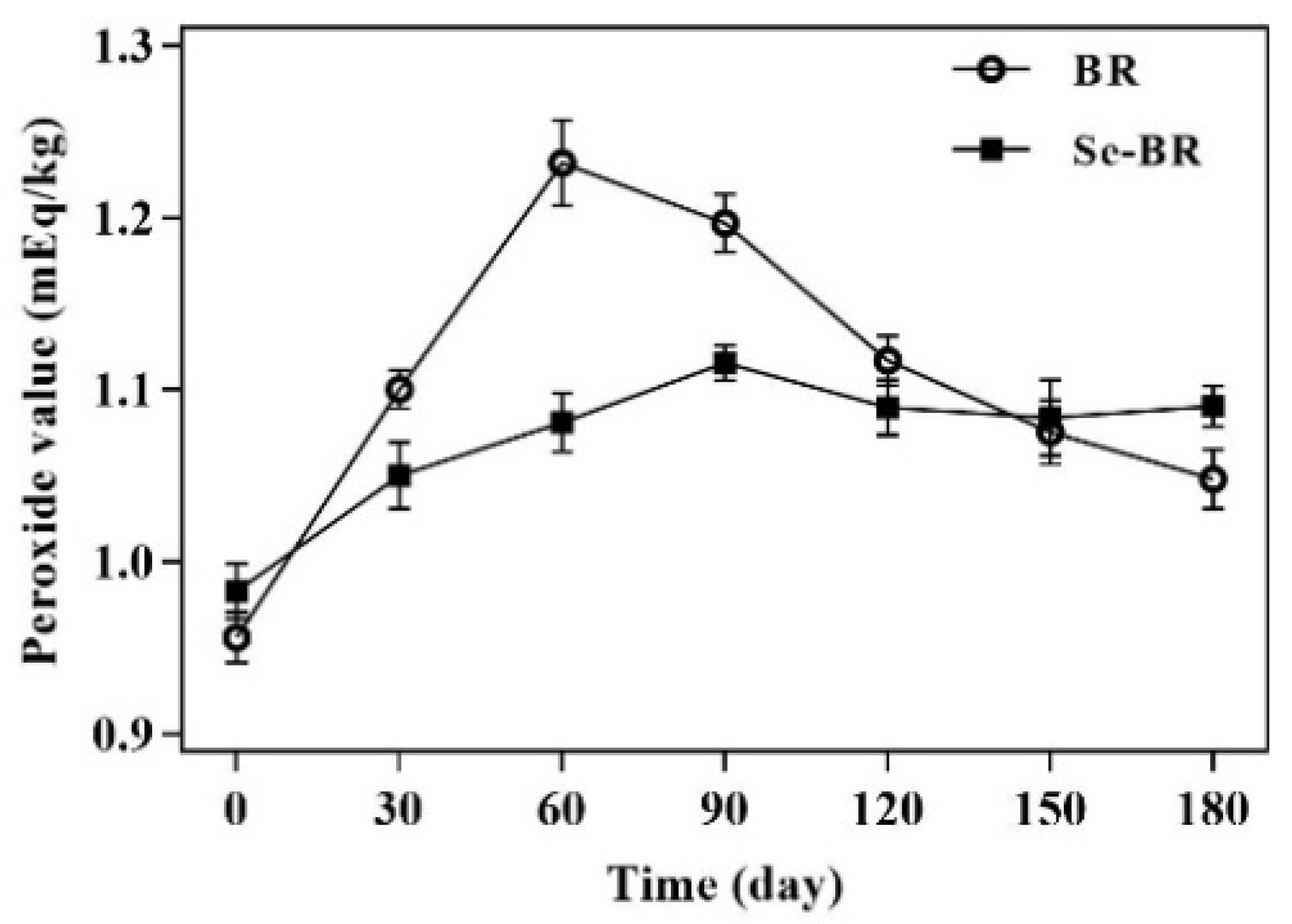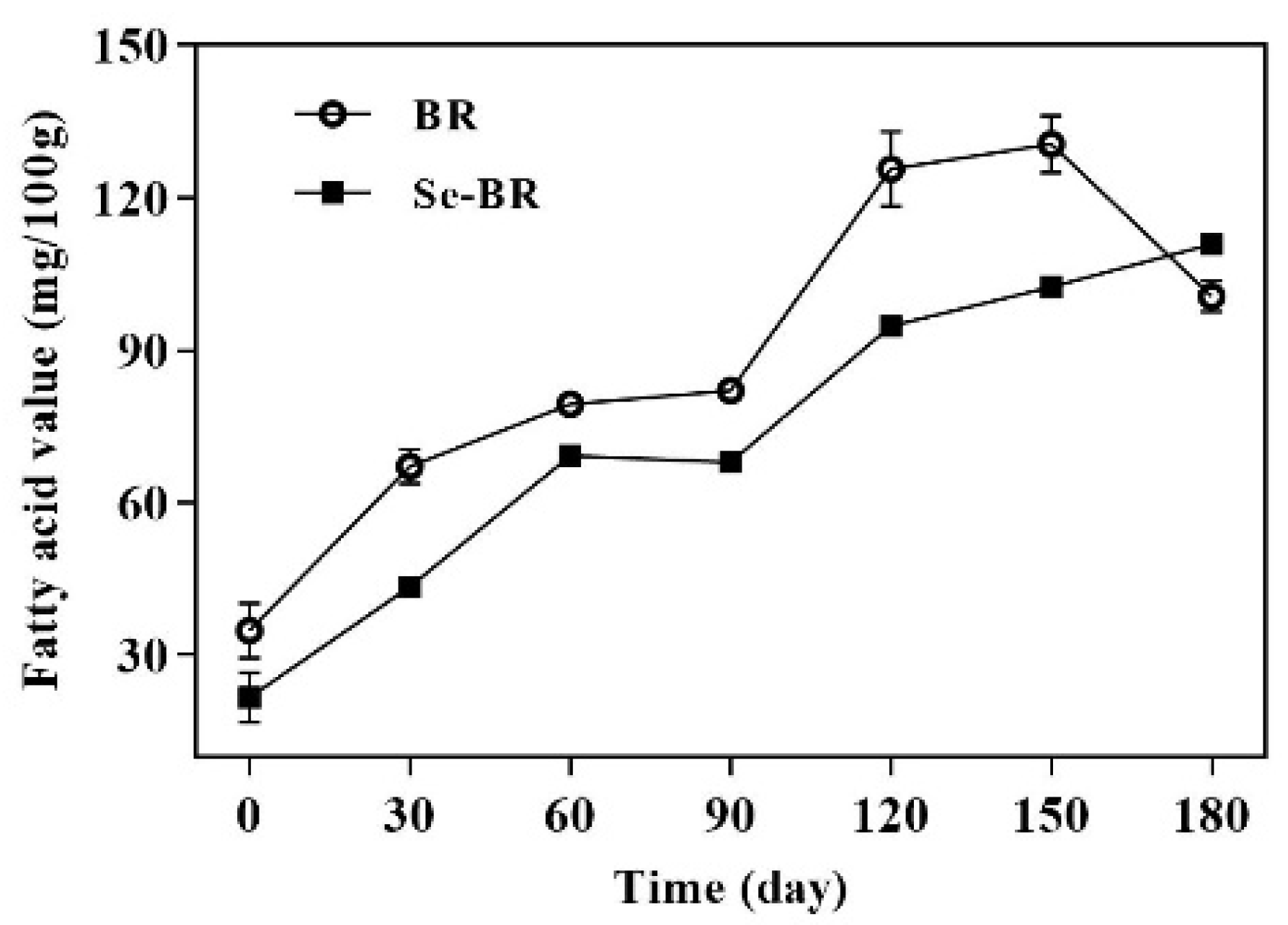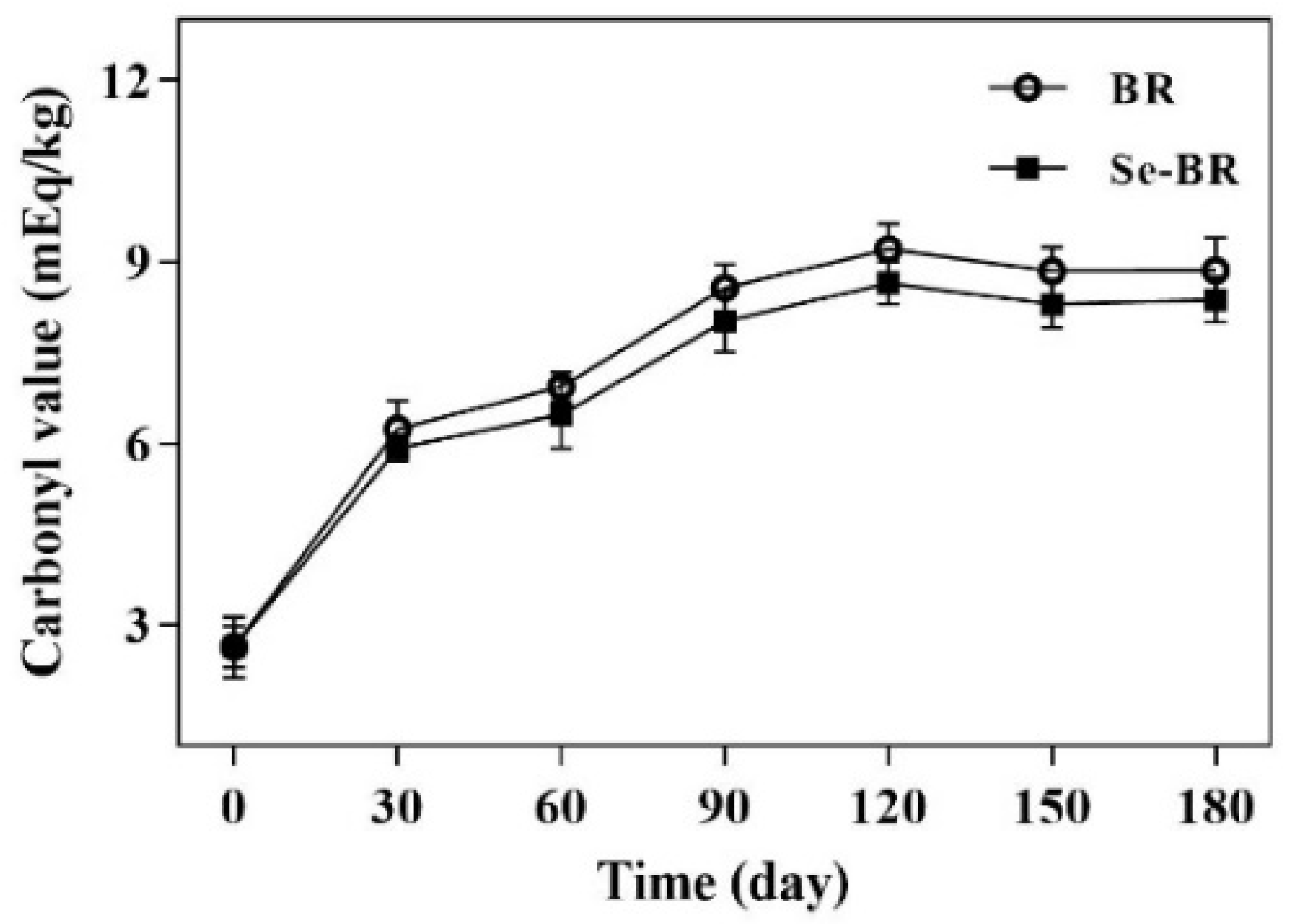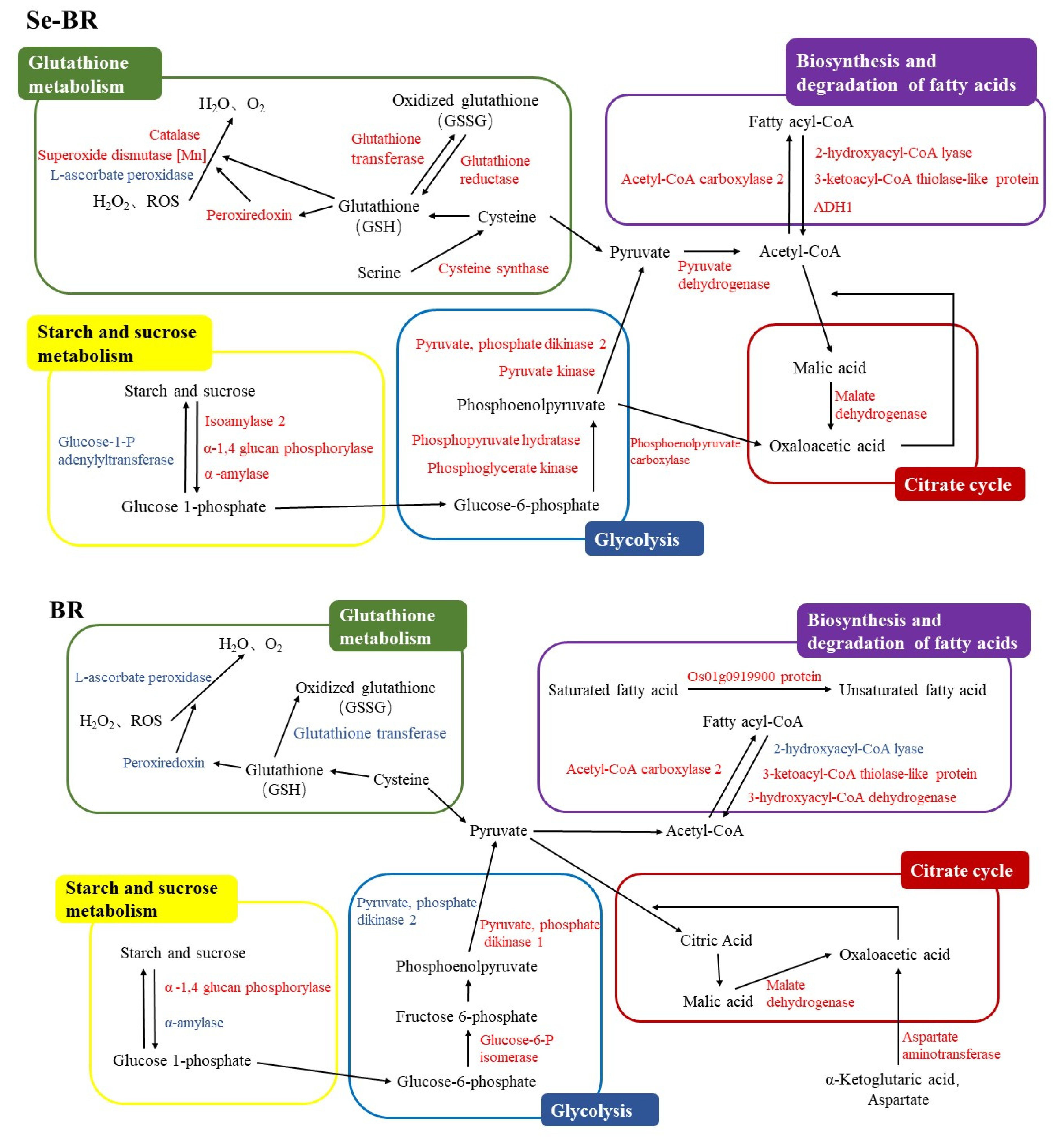Lipid and Protein Oxidation of Brown Rice and Selenium-Rich Brown Rice during Storage
Abstract
1. Introduction
2. Materials and Methods
2.1. Sample
2.2. Storage Conditions
2.3. Preparation of Brown Rice Oil
2.4. Preparation of Brown Rice Protein
2.5. Determination of Peroxide Value (PV)
2.6. Determination of Fatty Acid Value (FAV)
2.7. Determination of Carbonyl Value (CV)
2.8. Fourier-Transformed Infrared (FTIR) Spectroscopy
2.9. Proteomic Analysis
2.9.1. Protein Extraction
2.9.2. Protein Quantification
2.9.3. Protein Filter-Aided Sample Preparation (FASP) Enzymatic Lysis
2.9.4. Labeling and Analysis of iTRAQ Reagent
2.10. Statistical Analysis
3. Results and Discussion
3.1. Effect of Storage on Peroxide Value
3.2. Effect of Storage on Fatty Acid Value
3.3. Effect of Storage on Carbonyl Value
3.4. Analysis of FTIR Spectra
3.5. Proteomic Analysis
3.5.1. Gene Ontology (GO) Analysis
3.5.2. Kyoto Encyclopedia of Genes and Genomes (KEGG) Pathway Analysis
4. Conclusions
Supplementary Materials
Author Contributions
Funding
Institutional Review Board Statement
Informed Consent Statement
Data Availability Statement
Conflicts of Interest
References
- Liu, K.; Zhao, Y.; Chen, F.; Gu, Z.; Bu, G. Purification, identification, and in vitro antioxidant activities of selenium-containing proteins from selenium-enriched brown rice. Eur. Food Res. Technol. 2011, 234, 61–68. [Google Scholar] [CrossRef]
- Liu, K.; Ning, M. Antioxidant activity stability and digestibility of protein from Se-enriched germinated brown rice. LWT 2021, 142, 111032. [Google Scholar] [CrossRef]
- Xia, X.; Zhang, X.; Liu, M.; Duan, M.; Zhang, S.; Wei, X.; Liu, X. Toward improved human health: Efficacy of dietary selenium on immunity at the cellular level. Food Funct. 2021, 12, 976–989. [Google Scholar] [CrossRef] [PubMed]
- Zhang, L.; Zeng, H.; Cheng, W.H. Beneficial and paradoxical roles of selenium at nutritional levels of intake in healthspan and longevity. Free Radic. Biol. Med. 2018, 127, 3–13. [Google Scholar] [CrossRef] [PubMed]
- Radomska, D.; Czarnomysy, R.; Radomski, D.; Bielawska, A.; Bielawski, K. Selenium as a bioactive micronutrient in the human diet and its cancer chemopreventive activity. Nutrients 2021, 13, 1649. [Google Scholar] [CrossRef]
- Rotruck, J.T.; Pope, A.L.; Ganther, H.E.; Swanson, A.B.; Hoekstra, D. Selenium: Biochemical role as a component of glutathione peroxidase. Science 1973, 179, 588–590. [Google Scholar] [CrossRef]
- Thiry, C.; Ruttens, A.; De Temmerman, L.; Schneider, Y.-J.; Pussemier, L. Current knowledge in species-related bioavailability of selenium in food. Food Chem. 2012, 130, 767–784. [Google Scholar] [CrossRef]
- Fukagawa, N.K.; Ziska, L.H. Rice: Importance for global nutrition. J. Nutr. Sci. Vitaminol. 2019, 65, S2–S3. [Google Scholar] [CrossRef]
- Liu, K.; Chen, F.; Zhao, Y.; Gu, Z.; Yang, H. Selenium accumulation in protein fractions during germination of Se-enriched brown rice and molecular weights distribution of Se-containing proteins. Food Chem. 2011, 127, 1526–1531. [Google Scholar] [CrossRef]
- Kim, A.-N.; Kim, O.W.; Kim, H. Degradation kinetics of physicochemical and sensory properties of rice during storage at different temperatures. LWT 2022, 164, 113688. [Google Scholar] [CrossRef]
- Li, Y.; Liu, K.; Chen, F.; Cheng, Y. Comparative proteomics analysis reveals the effect of germination and selenium enrichment on the quality of brown rice during storage. Food Chem. 2018, 269, 220–227. [Google Scholar] [CrossRef]
- Zainudin, M.A.M.; Poojary, M.M.; Jongberg, S.; Lund, M.N. Light exposure accelerates oxidative protein polymerization in beef stored in high oxygen atmosphere. Food Chem. 2019, 299, 125132. [Google Scholar] [CrossRef]
- Peng, B.; He, L.; Tan, J.; Zheng, L.; Zhang, J.; Qiao, Q.; Wang, Y.; Gao, Y.; Tian, X.; Liu, Z.; et al. Effects of rice aging on its main nutrients and quality characters. J. Agric. Sci. 2019, 11, 44. [Google Scholar] [CrossRef]
- Zhang, W.; Xiao, S.; Ahn, D.U. Protein oxidation: Basic principles and implications for meat quality. Crit. Rev. Food Sci. Nutr. 2013, 53, 1191–1201. [Google Scholar] [CrossRef]
- Shen, H.; Stephen Elmore, J.; Zhao, M.; Sun, W. Effect of oxidation on the gel properties of porcine myofibrillar proteins and their binding abilities with selected flavour compounds. Food Chem. 2020, 329, 127032. [Google Scholar] [CrossRef]
- He, J.; Xia, C.; He, Y.; Pan, D.; Cao, J.; Sun, Y.; Zeng, X. Proteomic responses to oxidative damage in meat from ducks exposed to heat stress. Food Chem. 2019, 295, 129–137. [Google Scholar] [CrossRef]
- Pan, J.; Lian, H.; Jia, H.; Hao, R.; Wang, Y.; Ju, H.; Li, S.; Dong, X. Dose affected the role of gallic acid on mediating gelling properties of oxidatively stressed Japanese seerfish myofibrillar protein. LWT 2020, 118, 108849. [Google Scholar] [CrossRef]
- Chen, X.; Xiong, Y.L.; Xu, X. High-pressure homogenization combined with sulfhydryl blockage by hydrogen peroxide enhance the thermal stability of chicken breast myofibrillar protein aqueous solution. Food Chem. 2019, 285, 31–38. [Google Scholar] [CrossRef]
- Zhou, L.; Sun, Y.; Wu, F. Effects of oxidation by malondialdehyde on the structure and function of rice bran protein. Food Sci. 2019, 40, 98–107. [Google Scholar]
- Zhao, Q.Y.; Lin, J.H.; Wang, C.; Yousaf, L.; Xue, Y.; Shen, Q. Protein structural properties and proteomic analysis of rice during storage at different temperatures. Food Chem. 2021, 361, 130028. [Google Scholar] [CrossRef]
- Wu, X.; Liu, M.; Zhu, H.; Wang, J.; Dai, W.; Li, J.; Zhu, D.; Tang, W.; Xiao, Y.; Lin, J.; et al. Ubiquitin-specific protease 3 promotes cell migration and invasion by interacting with and deubiquitinating SUZ12 in gastric cancer. J. Exp. Clin. Cancer Res 2019, 38, 277. [Google Scholar] [CrossRef] [PubMed]
- Yang, M.; Gao, X.; Dong, J.; Gandhi, N.; Cai, H.; von Wettstein, D.H.; Rustgi, S.; Wen, S. Pattern of protein expression in developing wheat grains identified through proteomic analysis. Front. Plant Sci. 2017, 8, 962. [Google Scholar] [CrossRef] [PubMed]
- Mehta, B.M.; Darji, V.B.; Aparnathi, K.D. Comparison of five analytical methods for the determination of peroxide value in oxidized ghee. Food Chem. 2015, 185, 449–453. [Google Scholar] [CrossRef] [PubMed]
- Shu, Z.X.; Jia, W.Q.; Zhang, W.; Wang, P.P. Selected quality attributes of paddy rice as affected by storage temperature history. Int. J. Food Prop. 2021, 24, 316–324. [Google Scholar] [CrossRef]
- Hasan, M.M.; Sood, V.; Erkinbaev, C.; Paliwal, J.; Suman, S.; Rodas-Gonzalez, A. Principal component analysis of lipid and protein oxidation products and their impact on color stability in bison longissimus lumborum and psoas major muscles. Meat Sci. 2021, 178, 108523. [Google Scholar] [CrossRef]
- Wang, X.J.; Shen, Y.; Sun, D.L.; Bian, N.F.; Shi, P.X.; Zhang, Z.M.; Chen, Z.D.; Liu, Y.H.; Shen, Y.; Wang, X. iTRAQ-based proteomic reveals cell cycle and translation regulation involving in peanut buds cold stress. Russ. J. Plant Physiol. 2020, 67, 103–110. [Google Scholar] [CrossRef]
- Zhou, H.F.; Wu, Z.H.; Chang, X.J.; Tang, Y.; Yuan, J.L.; Li, X.; Yang, A.S.; Tong, P.; Chen, H.B. The effect of roasting on peanut allergens’ digestibility, allergenicity, and structure. Food Biosci. 2021, 44, 101454. [Google Scholar] [CrossRef]
- Ali, M.A.; Islam, M.A.; Othman, N.H.; Noor, A.M.; Hossen, J.; Ibrahim, M. Effect of heating on compositional characteristics and oxidative stability of crude and refined rice bran oil. J. Oleo Sci. 2019, 68, 1085–1097. [Google Scholar] [CrossRef]
- Yan, W.; Liu, Q.; Wang, Y.; Tao, T.T.; Liu, B.; Liu, J.; Ding, C. Inhibition of lipid and aroma deterioration in rice bran by infrared heating. Food Bioproc. Tech. 2020, 13, 1677–1687. [Google Scholar] [CrossRef]
- Li, Y.; Liu, K.; Chen, F. Effect of selenium enrichment on the quality of germinated brown rice during storage. Food Chem. 2016, 207, 20–26. [Google Scholar] [CrossRef]
- Davies, M.J. Protein oxidation and peroxidation. Biochem. J. 2016, 473, 805–825. [Google Scholar] [CrossRef] [PubMed]
- Singh, T.P.; Sogi, D.S. Comparative study of structural and functional characterization of bran protein concentrates from superfine, fine and coarse rice cultivars. Int. J. Biol. Macromol. 2018, 111, 281–288. [Google Scholar] [CrossRef] [PubMed]
- Qi, B.; Zhao, C.; Jiang, L.; Wang, Z.; Li, Y. Effect of composition and secondary structure of soybean protein isolate on surface hydrophobicity. Zhongguo Shipin Xuebao 2018, 18, 288–293. [Google Scholar] [CrossRef]
- Blanco, F.; Ramirez-Alvarado, M.; Serrano, L. Formation and stability of beta-hairpin structures in polypeptides. Curr. Opin. Struct. Biol. 1998, 8, 107–111. [Google Scholar] [CrossRef] [PubMed]
- Jiang, C.J.; Shimono, M.; Maeda, S.; Inoue, H.; Mori, M.; Hasegawa, M.; Sugano, S.; Takatsuji, H. Suppression of the rice fatty-acid desaturase gene OsSSI2 enhances resistance to blast and leaf blight diseases in rice. Mol. Plant-Microbe Interact. 2009, 22, 820–829. [Google Scholar] [CrossRef]
- Pye, V.E.; Christensen, C.E.; Dyer, J.H.; Arent, S.; Henriksen, A. Peroxisomal plant 3-ketoacyl-CoA thiolase structure and activity are regulated by a sensitive redox switch. J. Biol. Chem. 2010, 285, 24078–24088. [Google Scholar] [CrossRef]
- Fraccascia, P.; Casteels, M.; De Schryver, E.; Van Veldhoven, P.P. Role of thiamine pyrophosphate in oligomerisation, functioning and import of peroxisomal 2-hydroxyacyl-CoA lyase. Biochim. Biophys. Acta Proteins Proteom. 2011, 1814, 1226–1233. [Google Scholar] [CrossRef]
- Yucebilgic, G.; Bozdemir, Y. Catalase and superoxide dismutase enzymes activities in flaxseed (linum usitatissimum) extract. Asian J. Chem. 2010, 22, 2013–2017. [Google Scholar]
- Zhang, Z.; Xu, Y.; Xie, Z.; Li, X.; He, Z.-H.; Peng, X.-X. Association–dissociation of glycolate oxidase with aatalase in rice: A potential switch to modulate intracellular H2O2 levels. Mol. Plant. 2016, 9, 737–748. [Google Scholar] [CrossRef]
- Oakley, A. Glutathione transferases: A structural perspective. Drug Metab. Rev. 2011, 43, 138–151. [Google Scholar] [CrossRef]
- Board, P.G.; Menon, D. Glutathione transferases, regulators of cellular metabolism and physiology. Biochim. Biophys. Acta Gen. Subj. 2013, 1830, 3267–3288. [Google Scholar] [CrossRef]
- Venkatesh, J.; Park, S.W. Role of L-ascorbate in alleviating abiotic stresses in crop plants. Bot. Stud. 2014, 55, 38. [Google Scholar] [CrossRef] [PubMed]
- Wu, M.Y.; Deng, C.J.; Lo, T.H.; Chan, K.Y.; Li, X.; Wong, C.M. Peroxiredoxin, senescence, and cancer. Cells 2022, 11, 1772. [Google Scholar] [CrossRef] [PubMed]
- Smiri, M.; Jelali, N.; El Ghoul, J. Role for plant peroxiredoxin in cadmium chelation. J. Plant Interact 2013, 8, 255–262. [Google Scholar] [CrossRef]
- Wu, Y.H.; Jiang, L.; Ning, G.; Chu, L.; Liu, W.; Wang, Y.H.; Zhao, Y.L. A sensitive and simple impedance sensing strategy for glutathione and glutathione reductase activity detection. J. Anal. Chem. 2019, 74, 505–512. [Google Scholar] [CrossRef]
- Sekula, B.; Ruszkowski, M.; Dauter, Z. Structural analysis of phosphoserine aminotransferase (Isoform 1) from Arabidopsis thaliana- the enzyme involved in the phosphorylated pathway of serine biosynthesis. Front. Plant Sci. 2018, 9, 876. [Google Scholar] [CrossRef]
- Kharwar, S.; Bhattacharjee, S.; Mishra, A.K. Bioinformatics analysis of enzymes involved in cysteine biosynthesis: First evidence for the formation of cysteine synthase complex in cyanobacteria. 3 Biotech. 2021, 11, 354. [Google Scholar] [CrossRef]




| Species | Time (d) | β-Sheet (%) | Random Coil (%) | α-Helix (%) | β-Turn (%) |
|---|---|---|---|---|---|
| BR | 0 | 26.80 ± 0.26 b | 23.41 ± 0.18 a | 22.57 ± 0.02 b | 27.22 ± 0.06 b |
| 90 | 29.37 ± 0.91 c | 24.10 ± 0.34 a | 21.51 ± 0.64 b | 25.02 ± 1.22 ab | |
| 180 | 23.74 ± 0.30 a | 34.41 ± 0.20 b | 17.11 ± 0.43 a | 24.73 ± 0.52 ab | |
| Se-BR | 0 | 28.75 ± 0.07 a | 23.99 ± 0.07 a | 21.57 ± 0.09 a | 25.69 ± 0.09 b |
| 90 | 28.99 ± 1.11 a | 24.50 ± 0.06 b | 21.06 ± 0.68 a | 25.45 ± 1.86 b | |
| 180 | 29.15 ± 0.29 a | 28.39 ± 0.09 c | 26.70 ± 0.21 b | 15.76 ± 0.16 a |
| Groups | Total Trusted Proteins | Total Differential Proteins | Upregulated Proteins | Downregulated Proteins |
|---|---|---|---|---|
| Se-0:Se-6 | 2992 | 235 | 167 | 68 |
| BR-0:BR-6 | 2992 | 237 | 138 | 99 |
| BR-0:Se-0 | 2992 | 113 | 48 | 65 |
| BR-6:Se-6 | 2992 | 213 | 129 | 84 |
| Citable Accession | No. | Name | BR-0:Se-0 | BR-0:BR-6 | Se-0:Se-6 | BR-6:Se-6 |
|---|---|---|---|---|---|---|
| Peroxisome | ||||||
| B7EAG0 | 136 | Catalase | 0.6026 | 0.5248 | 1.8030 | 2.0512 |
| Q6YT73 | 738 | Glycolate oxidase 5 | - | 1.5996 | - | - |
| Q43008 | 352 | Superoxide dismutase [Mn], mitochondrial | - | - | 4.6989 | 2.6546 |
| Glutathione metabolism | ||||||
| Q93WM2 | 1508 | Glutathione transferase | - | 2.8314 | - | 0.5445 |
| Q945W6 | 2338 | Glutathione transferase | 0.6368 | 0.6607 | - | - |
| Q93WY5 | 892 | Glutathione transferase | - | 0.6607 | 1.5417 | 2.0512 |
| Q0JJ25 | 1175 | Glutathione transferase | - | - | 1.5417 | - |
| B7ERQ1 | 145 | Peroxiredoxin | 0.4285 | 0.5200 | 2.0324 | - |
| P48642 | 749 | Glutathione reductase, cytosolic | - | - | 1.5996 | 1.5136 |
| A0A345YV75 | 1753 | L-ascorbate peroxidase | - | 0.6081 | 0.5058 | - |
| Q8S5T1 | 1410 | Glutathione reductase | - | - | 1.5560 | - |
| Cysteine and methionine metabolism | ||||||
| Q8LMR0 | 317 | Phosphoserine aminotransferase | - | - | 1.9588 | - |
| Q0JJ47 | 50 | Aspartate aminotransferase | 2.0512 | 2.5351 | - | - |
| Q2QLY4 | 72 | 5-methyltetrahydropteroyltriglutamate-homocysteine methyltransferase 2 | - | - | 2.1677 | 1.5276 |
| Q9XEA8 | 506 | Cysteine synthase | - | - | 5.5976 | 3.8019 |
| Fatty acid degradation | ||||||
| Q0JMH0 | 357 | 2-hydroxyacyl-CoA lyase | 0.2992 | 0.4613 | 3.7325 | 2.4434 |
| S4U008 | 178 | 3-hydroxyacyl-CoA dehydrogenase | - | 1.7539 | - | - |
| Q84P96 | 304 | 3-ketoacyl-CoA thiolase-like protein | - | 1.7539 | 1.5704 | - |
| D7PPK3 | 176 | ADH1 | - | - | 20.7014 | 14.0605 |
| Biosynthesis of unsaturated fatty acids | ||||||
| A0A0N7KEB1 | 1635 | Os01g0919900 protein | - | 1.5136 | - | - |
| Starch and sucrose metabolism | ||||||
| D0TZR4 | 79 | Starch synthase, chloroplastic/amyloplastic | 2.0512 | 1.9409 | 0.5495 | 0.5861 |
| R4JL77 | 51 | Starch synthase, chloroplastic/amyloplastic (Fragment) | 0.2109 | 0.2014 | - | - |
| B7ESH5 | 2300 | Starch synthase, chloroplastic/amyloplastic | 0.3733 | 0.4875 | 2.0893 | 1.5849 |
| Q69T99 | 402 | Glucose-1-phosphate adenylyltransferase small subunit 1, chloroplastic/amyloplastic | - | 0.5754 | 0.5546 | - |
| B9EY77 | 32 | Glucose-1-phosphate adenylyltransferase | 1.5136 | 1.7061 | - | 0.6668 |
| Q6AU80 | 984 | Isoamylase 2, chloroplastic | - | - | 46.1318 | 39.0841 |
| Q8LQ33 | 510 | Alpha-1,4 glucan phosphorylase | - | 2.7290 | 6.9823 | 3.3113 |
| B3IYE3 | 16 | Alpha-1,4 glucan phosphorylase | - | 2.1086 | 2.4889 | - |
| Q0J528 | 520 | Alpha-amylase | 0.4529 | 0.3981 | 2.9648 | 3.2810 |
| Q0J136 | 123 | Glucose-6-phosphate isomerase | - | 1.7378 | - | - |
| D0TZK6 | 1186 | 1,4-alpha-glucan branching enzyme | - | 0.5445 | - | - |
| Q0D9D0 | 9 | 1,4-alpha-glucan branching enzyme | - | 2.7542 | - | 0.4207 |
| Q0J8G4 | 448 | Fructokinase-2 | - | - | 1.5276 | - |
| B9FUP9 | 737 | Amylomaltase | - | - | 1.5417 | - |
| Q653V7 | 33 | Probable alpha-glucosidase Os06g0675700 | - | - | 1.7539 | 1.9055 |
| Q93 × 08 | 26 | UTP--glucose-1-phosphate uridylyltransferase | - | - | 1.6444 | 1.5276 |
| A3AC56 | 2331 | Trehalose 6-phosphate phosphatase | - | - | - | 1.8030 |
| Pyruvate metabolism | ||||||
| Q42972 | 536 | Malate dehydrogenase, glyoxysomal | 0.6368 | 0.4875 | 1.5417 | 1.9588 |
| A1YQK1 | 125 | Malate dehydrogenase | - | 1.6144 | 1.5136 | - |
| Q6AVA8 | 10 | Pyruvate, phosphate dikinase 1, chloroplastic | - | 3.0761 | - | 0.3873 |
| Q75KR1 | 113 | Pyruvate, phosphate dikinase 2 | - | 0.6026 | 1.5849 | 1.9588 |
| Q65WW3 | 488 | Os05g0474600 protein | - | 1.9055 | 2.9648 | 1.7219 |
| B9FK36 | 67 | Acetyl-CoA carboxylase 2 | - | 3.1333 | 1.7865 | 0.6368 |
| Q10LW8 | 361 | Hydroxyacylglutathione hydrolase, putative, expressed | - | 0.5808 | - | 1.5417 |
| Q7XKB5 | 203 | Pyruvate kinase | - | - | 3.3729 | 3.6308 |
| Q9FYX8 | 362 | Phosphoenolpyruvate carboxylase | 0.6310 | - | 2.8054 | 2.2909 |
| D7PPK3 | 176 | ADH1 | - | - | 20.7014 | 14.0605 |
| Q6Z5N4 | 1472 | Pyruvate dehydrogenase E1 component subunit alpha-1, mitochondrial | - | - | 3.7325 | 4.7424 |
| Q7XTJ3 | 974 | Pyruvate dehydrogenase E1 component subunit alpha-3, chloroplastic | - | - | 1.9055 | |
| Q7XAL3 | 1500 | Acetyltransferase component of pyruvate dehydrogenase complex | 1.6293 | - | 0.5861 | - |
| Q5JKW5 | 177 | Malic enzyme | - | - | 1.6904 | - |
| A3BQD6 | 101 | Glyoxalase I | - | - | - | 1.6444 |
| Glycolysis/Gluconeogenesis | ||||||
| Q655T1 | 294 | Phosphoglycerate kinase | - | - | 3.6983 | 3.2211 |
| A1YQJ3 | 54 | Phosphopyruvate hydratase | - | - | 1.7378 | 1.7219 |
| B9F7T1 | 205 | Pyruvate decarboxylase | - | - | 2.3550 | 1.9953 |
| Q84TX6 | 361 | Hydroxyacylglutathione hydrolase, putative, expressed | - | 0.5808 | - | 1.5417 |
| Citrate cycle (TCA cycle) | ||||||
| Q6ZL94 | 684 | Succinate-CoA ligase [ADP-forming] subunit alpha | - | 1.5276 | - | - |
| Q7XVM2 | 442 | Dihydrolipoyllysine-residue succinyltransferase | - | - | 1.5704 | - |
Publisher’s Note: MDPI stays neutral with regard to jurisdictional claims in published maps and institutional affiliations. |
© 2022 by the authors. Licensee MDPI, Basel, Switzerland. This article is an open access article distributed under the terms and conditions of the Creative Commons Attribution (CC BY) license (https://creativecommons.org/licenses/by/4.0/).
Share and Cite
Zhang, M.; Liu, K. Lipid and Protein Oxidation of Brown Rice and Selenium-Rich Brown Rice during Storage. Foods 2022, 11, 3878. https://doi.org/10.3390/foods11233878
Zhang M, Liu K. Lipid and Protein Oxidation of Brown Rice and Selenium-Rich Brown Rice during Storage. Foods. 2022; 11(23):3878. https://doi.org/10.3390/foods11233878
Chicago/Turabian StyleZhang, Minghui, and Kunlun Liu. 2022. "Lipid and Protein Oxidation of Brown Rice and Selenium-Rich Brown Rice during Storage" Foods 11, no. 23: 3878. https://doi.org/10.3390/foods11233878
APA StyleZhang, M., & Liu, K. (2022). Lipid and Protein Oxidation of Brown Rice and Selenium-Rich Brown Rice during Storage. Foods, 11(23), 3878. https://doi.org/10.3390/foods11233878





